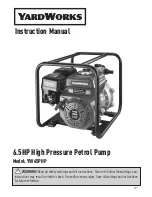
Page 19 of 40
Start:
This switch “arms” the emergency stop circuit. If the emergency stop button is used to
stop the machine (whether in an emergency or not) it will be necessary to depress this
switch before the machine will run again. Whenever the power to the machine is
disconnected and reconnected, it will be necessary to depress this switch before the
machine will run.
Speed Distance indicator:
This device will measure and display the distance travelled by the cable and also the
speed at which the cable is travelling. To toggle between speed and distance press
the SEL button. An R on the left side of the screen designates speed is being
displayed. To reset the distance to zero press the RST button.
Note: It is possible to reset the distance to zero even if speed is being displayed
on the screen.
Should it be necessary to replace the speed distance-measuring device please contact
CBS Products.
High/Low Torque Selector:
This allows the selection of the torque range the breeze operates in. For smaller cables
the low torque setting will give finer adjustment over low end torque for the machine.
Positions are UP for high torque and DOWN for low torque.
To install cable:
For the first time. i.e. installing a cable type that has not been installed before and
whose characteristics are unknown.
Connect the power to the machine.
The power supply should be nominally 115 volts single phase ac 50 or 60 Hz. This
may be derived from an IC engine driven generator, domestic or industrial electrical
supply, rotary converter or similar.
The power source should be fitted with a suitable connector, see “Connect the
electrical supply to the machine”. Page 15 of this manual.
Select the high/low torque switch position, in general, low torque should be used for
cable diameters less than 2.5mm or 0.01”. If in doubt initially use the low torque setting.
It is also recommended for small cables with low friction coatings that softer, black
drive wheels are used to improve blowing performance.
DO NOT SWITCH BETWEEN LOW AND HIGH TORQUE WHILE INSTALLING
CABLE
– THIS COULD RESULT IN DAMAGE TO THE CABLE.
Turn the torque control and speed control potentiometers anti clockwise to the
minimum position.
Press “start” button.
The machine will try to push the cable, with the torque control set to a minimum the
rollers will not turn or only very slowly.
It is now necessary to set the torque control to a position appropriate to the stiffness of
the cable and the characteristics of the cable insulation. See Appendix 2 for
recommendations. If the cable type has been installed before, the settings will be
available; the torque control potentiometer may be set at the previously determined
position.
Set the torque control potentiometer to the position determined above and turn the
speed control. The rollers will now start to turn and the cable will feed through the air
box (increase speed setting to max. if required). When the cable has travelled a
reasonable distance, (say 100metres) turn on the air feed, this will help the machine to
feed the cable.
The tube route, through which the cable is to be fed, should be configured in such a
way that the cable can feed all the way along the tube and out the other end. It will be
necessary to be able to determine when the cable has emerged at the other end of the
tube route. A typical way of achieving this aim is to have a colleague positioned at the















































